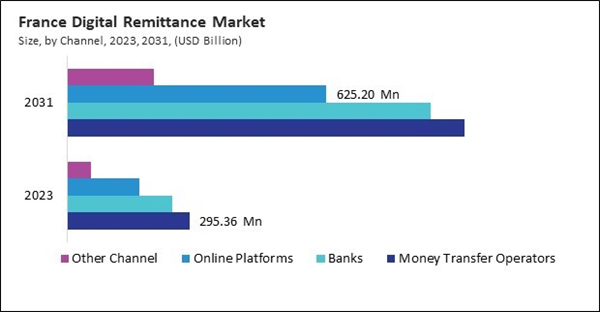The Germany market dominated the Europe Digital Remittance Market by country in 2023, and is expected to continue to be a dominant market till 2031; thereby, achieving a market value of $4.80 billion by 2031. UK market is experiencing a CAGR of 15.1% during 2024-2031. Additionally, the France market is expected to witness a CAGR of 16.9% during 2024-2031.
The growing demand for expedited and more efficient transactions has significantly contributed to the proliferation of digital remittance services. Instant or same-day transfers are provided by digital remittance services, which enable recipients to access their money rapidly in contrast to traditional bank transactions that may take several days to process. The use of blockchain technology and decentralized finance (DeFi) solutions has further reduced transaction times, ensuring seamless cross-border payments without intermediaries.
Additionally, integrating digital remittance services with super apps such as WeChat Pay, Alipay, and Google Pay has made it easier for users to send money directly from their smartphones, eliminating the need for physical bank visits or third-party remittance agents. This ease of access and transaction speed has benefited gig workers, freelancers, and small business owners who rely on international payments for their livelihoods.
Germany has seen a notable increase in digital remittance usage, primarily due to its large immigrant population and strong emphasis on technological innovation. According to the World Bank, people in the nation received approximately USD 21 billion of personal remittances in 2023. The government's support for fintech initiatives has fostered a competitive environment, developing user-friendly digital remittance platforms. Additionally, Germany's robust regulatory framework ensures secure and efficient transactions, encouraging the adoption of digital remittance services.
List of Key Companies Profiled
- Papaya Global Ltd.
- Digital Wallet Corporation
- WorldRemit Ltd.
- Nium Pte. Ltd.
- MoneyGram Payment Systems Inc.
- PayPal Holdings, Inc.
- Ria Financial Services Ltd.
- TransferGo Ltd.
- TransferWise Ltd.
- Western Union Holdings, Inc.
Market Report Segmentation
By Type
- Outward
- Inward
By Channel
- Money Transfer Operators
- Banks
- Online Platforms
- Other Channel
By End Use
- Personal
- Small Businesses
- Migrant Labor Workforce
- Other End Use
By Country
- Germany
- UK
- France
- Russia
- Spain
- Italy
- Rest of Europe
Table of Contents
Companies Mentioned
- Papaya Global Ltd.
- Digital Wallet Corporation
- WorldRemit Ltd.
- Nium Pte. Ltd.
- MoneyGram Payment Systems Inc.
- PayPal Holdings, Inc.
- Ria Financial Services Ltd.
- TransferGo Ltd.
- TransferWise Ltd.
- Western Union Holdings, Inc.
Methodology

LOADING...









